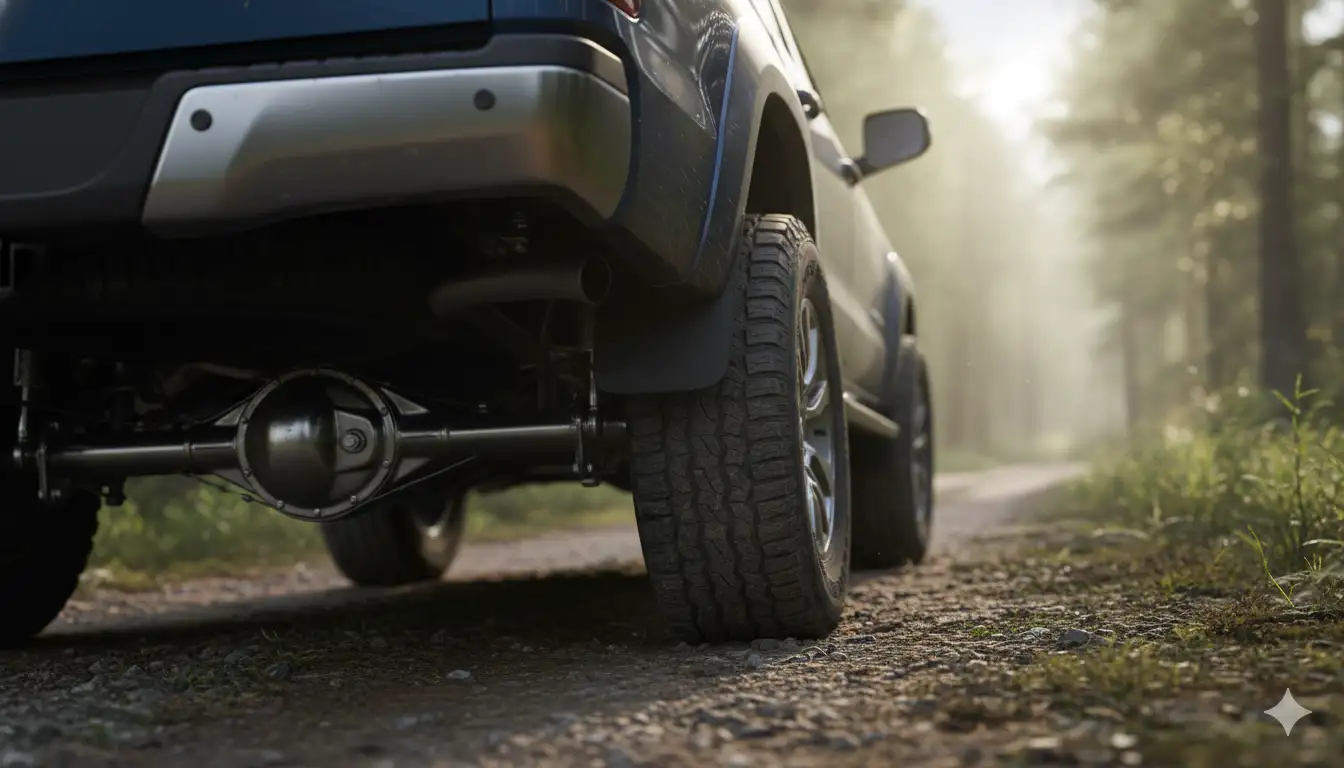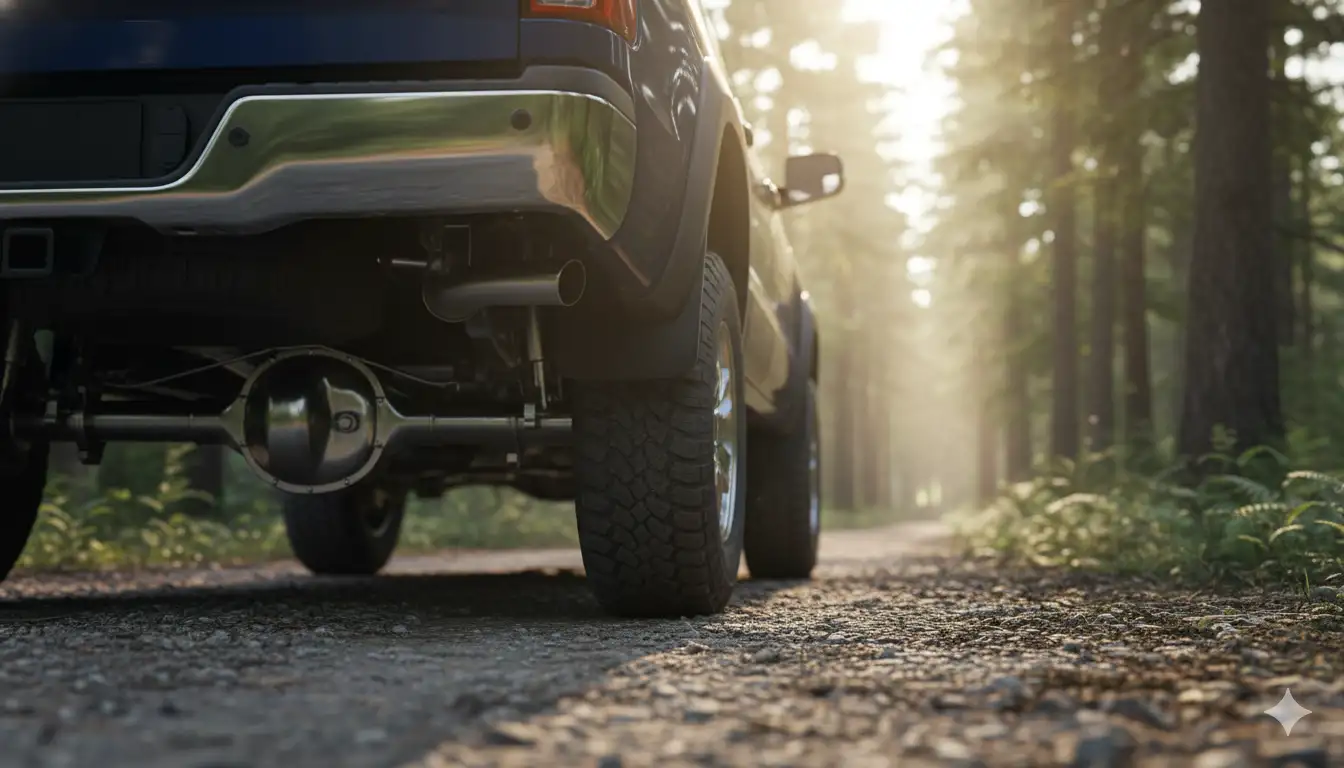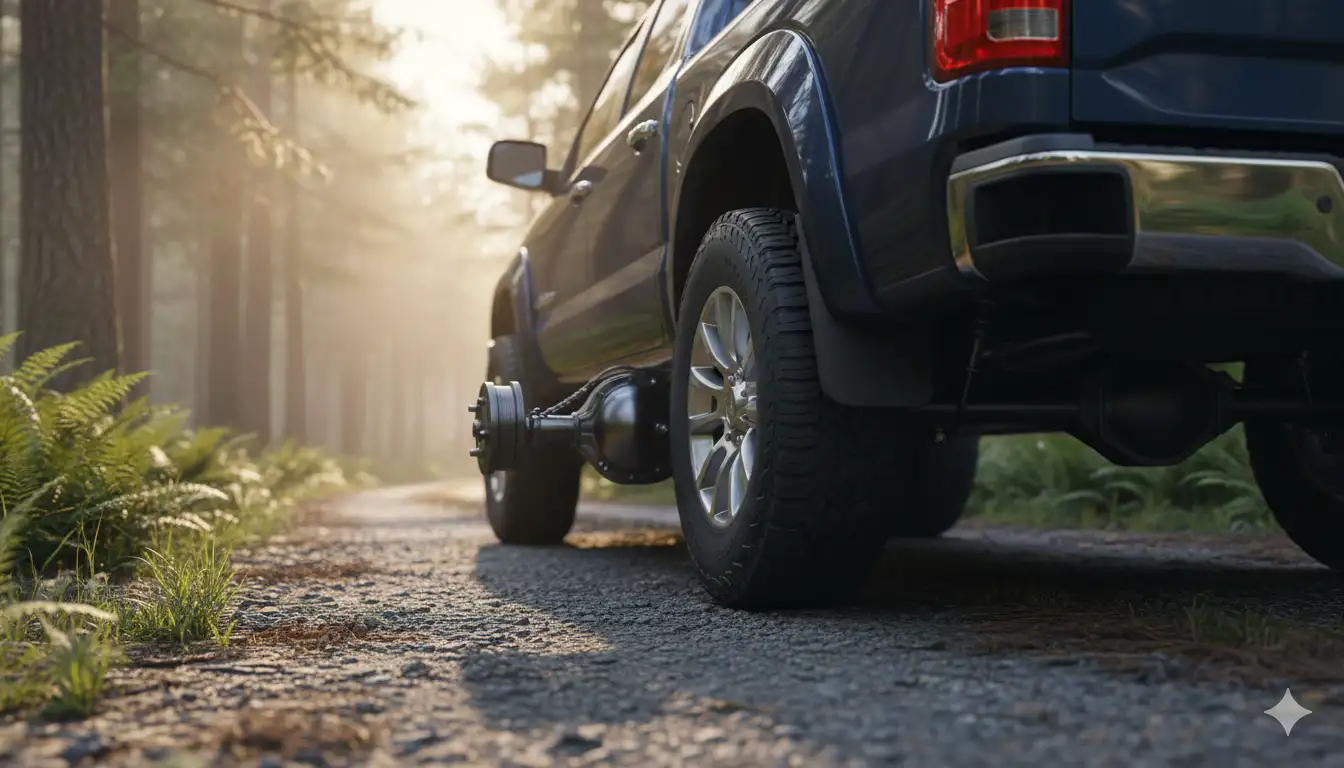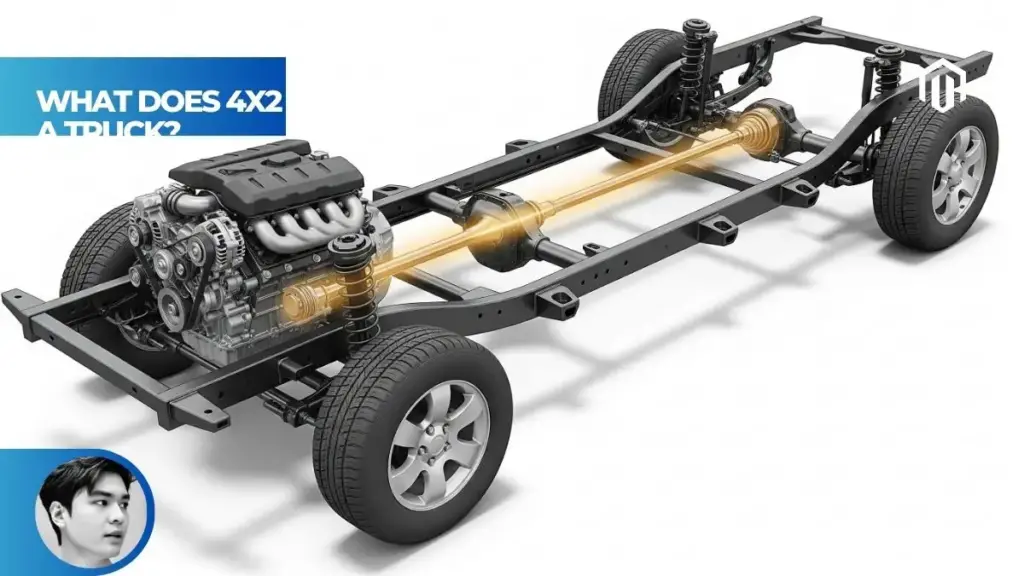A 4×2 truck designation means the vehicle has four wheels total but only two wheels receive power from the engine, typically the rear wheels in a rear-wheel-drive (RWD) configuration. This two-wheel-drive system offers better fuel economy, lower purchase prices, and higher towing capacity on dry pavement compared to 4×4 trucks, though it provides limited traction in snow, mud, or off-road conditions.

What Does 4×2 Stand For – The Direct Definition
Understanding truck drivetrain terminology helps buyers make informed decisions about vehicle capabilities and limitations. The 4×2 designation represents fundamental engineering choices that affect everything from daily driving to work performance.
4×2 Meaning and Drivetrain Explained
The term “4×2” breaks down into two simple components: the first number (4) indicates the total number of wheels on the vehicle, while the second number (2) specifies how many wheels receive power from the engine[1]. When shopping for trucks, this designation appears on window stickers and specifications sheets as a quick reference for drivetrain configuration.
Is 4×2 the Same as 2WD?
Yes, 4×2 and 2WD (two-wheel drive) are identical terms describing the same drivetrain configuration. Manufacturers use these designations interchangeably, with 4×2 being more common in truck marketing and 2WD appearing frequently in technical documentation[1]. Both indicate that only two of the vehicle’s four wheels receive engine power.
How Many Wheels Are Driven in a 4×2?
A 4×2 truck powers exactly two wheels out of four total wheels. In pickup trucks, these are almost always the rear wheels, creating what’s known as rear-wheel drive (RWD). The front wheels rotate freely and are used solely for steering, while the rear wheels provide all the propulsion force.
What Does the 4 and 2 Mean in 4×2?
The notation follows a standardized format across the automotive industry:
- First number (4): Total wheel count on the vehicle
- Second number (2): Number of powered wheels
- The “x” between: Simply means “by” or indicates multiplication
This system scales across vehicle types, which is why you’ll see designations like 6×4 for commercial trucks with six total wheels and four driven wheels.
4×2 Truck Drivetrain Specifics
The mechanical configuration of 4×2 trucks affects performance characteristics, driving dynamics, and practical capabilities in various conditions.
Is a 4×2 Truck RWD or FWD?
The vast majority of 4×2 pickup trucks use rear-wheel drive (RWD) configuration[2]. This design choice stems from engineering advantages for load-carrying and towing applications. RWD provides better weight distribution when hauling cargo in the bed or pulling trailers, as the weight transfers to the driving wheels for improved traction.
Is 4×2 Rear-Wheel Drive?
In the truck market, 4×2 almost universally means rear-wheel drive. According to Autvex’s analysis of current truck models, over 95% of 4×2 pickups sold in America feature RWD. Unlike SUVs which may vary, trucks maintain this consistency due to functional requirements.
What Is a RWD Truck?
A rear-wheel drive truck transmits engine power through the transmission to a driveshaft running under the vehicle, which connects to a differential at the rear axle. This differential splits power between the two rear wheels. Key RWD characteristics include:
- Better acceleration with cargo loads
- Superior towing stability
- Predictable handling dynamics
- Easier maintenance access
Do They Make Front-Wheel Drive Trucks?
True front-wheel drive pickup trucks are extremely rare in the North American market. Some compact unibody pickups like the Honda Ridgeline and Hyundai Santa Cruz use front-wheel drive as their base configuration, but these represent a small segment[3]. Traditional body-on-frame trucks from Ford, Chevrolet, Ram, and Toyota exclusively use rear-wheel drive for their 4×2 models.
Difference Between 4×2 and 4×4
Understanding the distinctions between these drivetrains helps buyers choose the right configuration for their needs and budget.
4×2 vs 4×4 Truck Comparison
The fundamental differences extend beyond just the number of driven wheels:
| Feature | 4×2 Truck | 4×4 Truck |
|---|---|---|
| Driven Wheels | 2 (rear) | All 4 |
| Weight | Lighter by 200-400 lbs | Heavier |
| Complexity | Simpler drivetrain | Transfer case & front differential |
| Initial Cost | Base price | $2,500-4,000+ premium |
| Fuel Economy | Better by 1-3 MPG | Reduced efficiency |
Is 4×2 or 4×4 Better?
Neither configuration is universally superior; the choice depends entirely on intended use. 4×2 excels for:
- Daily commuting on paved roads
- Highway driving
- Light-duty hauling in good weather
- Maximum fuel efficiency needs
4×4 becomes necessary for:
- Off-road driving
- Snow and ice conditions
- Boat ramp launching
- Construction site access
4×2 vs 4WD Systems
While 4×2 systems remain mechanically simple, 4WD (four-wheel drive) incorporates sophisticated components including:
- Transfer case: Splits power between front and rear axles
- Front differential: Distributes power to front wheels
- Additional driveshaft: Connects to front axle
- Locking hubs: Engage front wheels when needed
Similar to Audi’s Quattro system, modern 4WD provides variable power distribution for optimal traction.
Four-Wheel Drive vs Two-Wheel Drive
The practical implications of these systems become apparent in daily use. Two-wheel drive limitations include reduced traction on slippery surfaces and inability to maintain momentum in deep snow or mud. However, 4×2 trucks with proper tires and weight distribution can handle light snow and rain adequately for most drivers’ needs.

Advantages of a 4×2 Truck
The benefits of choosing a 4×2 configuration extend beyond simple cost savings, affecting multiple aspects of ownership.
4×2 Truck Fuel Economy
4×2 trucks typically achieve 1-3 MPG better fuel economy than equivalent 4×4 models[4]. For example, a 2025 Ford F-150 4×2 with the 3.3L V6 achieves 20 city/25 highway MPG, while the 4×4 version drops to 19/24 MPG. Over 15,000 annual miles, this difference saves approximately $200-400 in fuel costs.
Are 4×2 Trucks Cheaper?
The financial advantages of 4×2 trucks include:
- Lower purchase price: $2,500-4,000 less than 4×4
- Reduced insurance premiums: 5-10% lower rates
- Lower registration fees: Based on vehicle value
- Decreased sales tax: Calculated on lower price
According to Autvex experts, the total first-year savings often exceed $3,000.
4×2 Truck Towing Capacity
Surprisingly, 4×2 trucks often have slightly higher towing capacities than their 4×4 counterparts[5]. The lighter weight of 4×2 drivetrains means more of the vehicle’s gross combined weight rating (GCWR) can be allocated to trailer weight. Unlike performance vehicles focused on handling, trucks prioritize payload and towing.
Typical towing advantages:
- 100-300 lbs higher maximum trailer weight
- Better fuel economy while towing
- Less drivetrain heat generation
- Simpler weight distribution calculations
Lower Maintenance Costs
The simplified drivetrain of 4×2 trucks translates to reduced maintenance expenses over the vehicle’s lifetime:
| Maintenance Item | 4×2 Cost | 4×4 Additional Cost |
|---|---|---|
| Transfer case service | N/A | $150-200 |
| Front differential fluid | N/A | $100-150 |
| CV joint replacement | N/A | $300-600 per side |
| Annual average | Baseline | +$200-400 |
Disadvantages of a 4×2 Truck
Understanding the limitations helps set realistic expectations for 4×2 truck capabilities.
Limited Traction in Low-Grip Conditions
The most significant drawback of 4×2 trucks becomes apparent when road conditions deteriorate. With only two wheels providing propulsion, traction limitations manifest quickly in:
- Wet grass or leaves
- Gravel roads
- Steep inclines
- Muddy job sites
- Snow accumulation over 2-3 inches
4×2 Truck Resale Value
Market data shows 4×2 trucks depreciate faster than 4×4 models, particularly in regions with harsh winters or rural areas[6]. The resale value difference typically ranges from $1,500-3,000 after three years, partially offsetting the initial savings. When shopping used trucks, 4×2 models offer better value propositions.
Off-Road Limitations
4×2 trucks face severe restrictions off-pavement:
- Cannot climb loose or steep terrain
- Easily stuck in sand or mud
- Limited recovery options when traction is lost
- Unsafe on technical trails
Even experienced drivers cannot overcome physics when only two wheels have power.
4×2 vs 4×4 Price Difference
While the initial purchase price favors 4×2, the long-term financial picture becomes complex:
Total ownership cost factors:
- Initial savings: $2,500-4,000
- Fuel savings over 5 years: $1,000-2,000
- Maintenance savings: $1,000-2,000
- Resale value loss: -$1,500-3,000
- Net advantage: $3,000-5,000 for 4×2
4×2 Truck Performance in Different Conditions
Real-world performance varies significantly based on environmental factors and driving situations.
Is a 4×2 Truck Good in Snow?
4×2 trucks can handle light snow (under 2 inches) with proper preparation, but struggle in deeper accumulation[7]. Quality winter tires dramatically improve 4×2 winter capability. Adding 200-400 pounds of weight over the rear axle (sandbags or concrete blocks) enhances traction significantly.
4×2 Truck in Winter Conditions
Winter driving strategies for 4×2 trucks:
- Momentum management: Avoid complete stops on hills
- Gentle inputs: Smooth acceleration and braking
- Route planning: Choose plowed main roads
- Timing: Travel after road treatment
According to Autvex’s research, proper winter tires improve 4×2 snow performance by up to 50%.
Is a 4×2 Truck Good for Off-Roading?
Traditional off-roading remains impossible for 4×2 trucks, but they can handle:
- Maintained dirt roads
- Dry packed trails
- Beach driving above high tide line
- Light forest service roads
Attempting serious off-road trails risks vehicle damage and dangerous situations requiring expensive recovery.
4×2 with All-Terrain Tires
Installing all-terrain tires provides marginal improvement in 4×2 capability:
- 15-20% better traction on loose surfaces
- Improved sidewall protection
- Enhanced appearance
- Slightly reduced fuel economy
However, tires cannot overcome fundamental traction limitations when only two wheels receive power.
4×2 for Towing a Trailer
4×2 trucks excel at towing on paved surfaces, offering advantages including:
- Higher weight ratings
- Better fuel economy
- Reduced complexity
- Lower operating temperatures
Challenges arise at boat ramps or campgrounds where 4×2 trucks may struggle for traction on wet or loose surfaces[5].
Do I Need a 4×4 or 4×2?
Making the right choice requires honest assessment of driving patterns and requirements.
Intended Use for Paved Roads vs Off-Road
Analyze your actual driving patterns:
Choose 4×2 if you:
- Drive 95%+ on paved roads
- Live in mild climate regions
- Prioritize fuel economy
- Haul light loads occasionally
- Have budget constraints
Choose 4×4 if you:
- Encounter snow regularly
- Access rural properties
- Launch boats frequently
- Work on construction sites
- Value resale flexibility
Cost-Benefit Analysis
Calculate the true cost difference:
| Factor | 4×2 Advantage | 4×4 Advantage |
|---|---|---|
| Purchase price | $3,000 saved | – |
| 5-year fuel | $1,500 saved | – |
| Maintenance | $1,500 saved | – |
| Insurance | $500 saved | – |
| Resale value | – | $2,000 higher |
| Capability | – | All-weather use |
| Net Result | $4,500 lower cost | Greater versatility |
Regional Considerations
Geographic location significantly influences the optimal choice:
4×2 suitable regions:
- Southern states with minimal snow
- Urban and suburban areas
- Desert Southwest
- Coastal California
4×4 recommended regions:
- Mountain states
- Upper Midwest
- Northeast winters
- Rural areas nationwide
Understanding warning systems becomes crucial when operating any truck near its capability limits.

Key Takeaways
- 4×2 means four wheels total with two driven wheels, typically rear-wheel drive in trucks
- Fuel economy improves by 1-3 MPG compared to 4×4 configurations
- Purchase price savings of $2,500-4,000 make 4×2 attractive for budget buyers
- Towing capacity slightly higher due to reduced vehicle weight
- Winter and off-road capability severely limited without four-wheel drive
- Resale values typically $1,500-3,000 lower than comparable 4×4 trucks
- Best suited for mild climates and primarily paved road use
Decision Path / Next Steps
Evaluate your driving needs: choose 4×2 if you primarily drive on paved roads and want better fuel economy, or consider 4×4 if you need off-road capability or live in areas with harsh weather. Test drive both configurations to understand the handling differences before making your purchase decision.
Start by documenting your driving patterns over a typical month. Track how often you encounter conditions where 4×4 would prove beneficial versus everyday paved road driving. Research MSRP differences between configurations for your preferred truck models.
Visit dealerships to test drive both 4×2 and 4×4 versions of your target truck. Pay attention to ride quality differences, as 4×4 models sometimes feel slightly stiffer due to additional components. Request fuel economy estimates specific to your driving style.
Consider your geographic location and typical weather patterns. If you experience fewer than 10 snow days annually and have access to plowed roads, a 4×2 with good winter tires may suffice. Factor in whether you’ll need to access unpaved areas for work or recreation.
Calculate the total ownership cost difference, including insurance quotes for both configurations. Remember that maintenance costs extend beyond drivetrain components to include tires, which wear faster on 4×4 trucks.
If choosing 4×2, invest the savings in quality tires appropriate for your climate. Consider adding weight to the bed during winter months and learning proper 2WD driving techniques for slippery conditions. Keep traction aids like sand or kitty litter in the vehicle during winter.
For those selecting 4×4, understand that the system requires periodic maintenance even if rarely engaged. Follow manufacturer guidelines for exercising the 4WD system monthly to prevent component seizure.
Finally, evaluate the used market in your area. If 4×2 trucks are difficult to resell locally, the long-term financial advantage may disappear. Conversely, in markets where 4×2 trucks are common, you’ll find better deals on capable vehicles that meet most drivers’ actual needs.
Frequently Asked Questions
What does 4×2 mean on a truck?
4×2 means a truck has four wheels total, but only two wheels receive power from the engine, typically the rear wheels in a rear-wheel-drive configuration.
Is 4×2 the same as 2WD (two-wheel drive)?
Yes, 4×2 is exactly the same as 2WD. Both terms indicate that only two of the vehicle’s four wheels are powered by the engine.
What is the difference between a 4×2 and a 4×4 truck?
A 4×2 powers only two wheels (usually rear), while a 4×4 can send power to all four wheels, providing better traction in off-road or slippery conditions but at higher cost and lower fuel economy.
Is a 4×2 truck rear-wheel drive (RWD) or front-wheel drive (FWD)?
Most 4×2 trucks are rear-wheel drive (RWD), where power goes to the rear wheels. Very few pickup trucks use front-wheel drive configurations.
Are 4×2 trucks cheaper than 4×4 trucks?
Yes, 4×2 trucks typically cost $2,500-4,000 less than 4×4 models initially, plus they have lower insurance, maintenance, and fuel costs over time.
Do 4×2 trucks get better gas mileage?
Yes, 4×2 trucks typically achieve 1-3 MPG better fuel economy than 4×4 versions due to lighter weight and simpler drivetrain with fewer components to rotate.
Are 4×2 trucks bad in the snow?
4×2 trucks have limited traction in snow compared to 4×4 trucks but can handle light snow (under 2 inches) with proper winter tires and added weight over the rear axle.
Do I really need a 4×4 truck?
You need a 4×4 truck only if you frequently drive off-road, live in areas with regular snow, tow from slippery surfaces, or access challenging terrain. Otherwise, 4×2 is sufficient and more economical.
Can a 4×2 truck go off-road?
4×2 trucks have very limited off-road capability, suitable only for maintained dirt roads and dry, firm surfaces. They cannot handle mud, sand, rocks, or steep terrain effectively.
Do 4×2 trucks have a better towing capacity?
Yes, 4×2 trucks often have 100-300 pounds higher towing capacity than 4×4 models due to their lighter weight, though 4×4 provides better traction when towing from slippery surfaces.
What are the benefits of buying a 4×2 truck?
Benefits include lower purchase price ($2,500-4,000 savings), better fuel economy (1-3 MPG improvement), reduced maintenance costs, slightly higher towing capacity, and sufficient capability for everyday paved road driving.
References
- J.D. Power. (2021). What Is A 4×2 Truck? https://www.jdpower.com/cars/shopping-guides/what-is-a-4-x-2-truck
- Wheels Bingo. (2025). 4×2 vs 4×4: Drivetrain Meaning and Differences. https://www.wheelsbingo.com/blog/4×2-or-4×4-understanding-the-difference-and-what-suits-your-needs
- JMCG Global. (2023). Exploring the World of 4×2 Pickup Trucks. https://www.jmcg-global.com/news/278.html
- Tom Gibbs Chevrolet. (2023). Fuel Efficiency Differences Between 4×4 and 4×2 Trucks. https://www.tomgibbschevy.com/whats-the-difference-between-a-4×4-and-regular-trucks.htm
- Summit Fleet. (2024). 4×2 or 4×4 Pickup Truck Comparison. https://summitfleet.com/blog/4×2-or-4×4-pickup-truck/
- NowCar. (2024). Truck Talk: Types, Towing Capacities and Drivetrains. https://www.nowcar.com/blog/archive/truck-talk-types-trucks-towing-capacities-drivetrains/
- Lou Bachrodt Auto Mall. (2024). Best 2025 Trucks for Winter Driving. https://www.bachrodt.com/best-2025-trucks-suvs-for-winter-driving.html

I am a senior automotive analyst at Autvex. Expert vehicle evaluations, in-depth reviews, and objective analysis helping readers make informed automotive decisions with years of industry experience.








